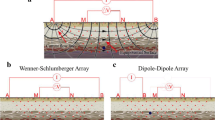Abstract
Moisture ingress is one of major damaging factors for masonry buildings. As the complex resistivity (CR) is sensitive to textural properties as well as to the pore fluid chemistry of wet porous media, its non-destructive application can provide helpful information for conservators. In a comprehensive laboratory study it has been shown that CR might even be able to distinguish between salt content and saturation degree in only one measurement. The combined use of electrical and electromagnetic measurement techniques in two field-scale flooding experiments has shown some unexpected differences. Possible reasons are discussed and it is shown that bringing together the information of both methods leads to a clearer picture.
Similar content being viewed by others
References
Kong, F., and T.L. By (1995), Radar tomography for non-destructive testing. In: Proc. Int. Symp. on Non-Destructive Testing in Civil Engineering, 26–28 Sept. 1995, Berlin, 681–688.
Kruschwitz, S. (2007), Assessment of the complex resistivity behavior of salt affected building materials, PhD thesis, Technical University of Berlin.
Kruschwitz, S., and E. Niederleithinger (2008), Complex resistivity (CR) an Baumaterial, vom Labor- zum Geländemaßstab. In Proc. 68th Annual Meeting of the German Geophysical Society (DGG), 3–6 March, 2008, Freiberg, Germany, GE4 (in Germany).
Maierhofer, C., and C. Colla (2000), Influence of moisture content on the detection of structural features in building construction using impulse radar. In: S. Alampali (ed.), Structural Materials Technology IV. An NDT Conference, Technomic Publishing Co., Atlantic City, NJ, 343–349.
Radic, T. (2004), Flyer of the SIP256c, Radic research, www.radic-research.de, http://www.radic-research.homepage.t-online.de/Flyer_SIP256C_ 161104.pdf.
Schön, J. (1996), Physical Properties of Rocks: Fundamentals and Principles of Petrophysics, Elsevier Science Publishers, Oxford.
Ulrich, C., and L. Slater (2004), Induced polarization measurements on unsaturated, unconsolidated sands, Geophysics 69, 3, 762–771, DOI: 10.1190/1.1759462.
Valle, S., and L. Zanzi (1998), Traveltime radar tomography for NDT on masonry and concrete structures, Eur. J. Environ. Eng. Geophys. 2, 3, 229–246.
Wendrich, A., Ch. Trela, M. Krause, Ch. Maierhofer, U. Effner, and J. Wöstmann (2006), Location of voids in masonry structures by using radar and ultrasonic traveltime tomography. In: Proc. 9th European Conference on NDT, 25-29 Sept. 2006, Berlin: DGZfP, BB 103-CD, Tu.3.2.5.
Author information
Authors and Affiliations
Corresponding author
Rights and permissions
About this article
Cite this article
Kruschwitz, S., Niederleithinger, E., Trela, C. et al. Complex resistivity and radar investigation of building material: First results of field scale measurements. Acta Geophys. 58, 96–113 (2010). https://doi.org/10.2478/s11600-009-0019-4
Received:
Accepted:
Published:
Issue Date:
DOI: https://doi.org/10.2478/s11600-009-0019-4




